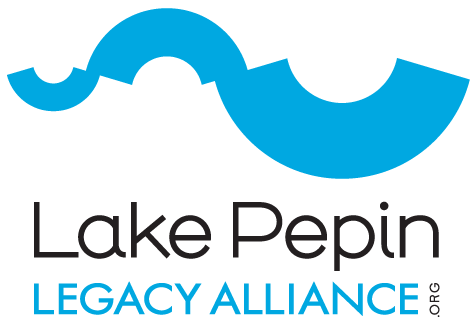By Emily Green
By now it is well documented that 85-90% of the sediment entering Lake Pepin comes from the Minnesota River, and approximately half of that comes from just two of its subwatersheds: the Blue Earth and the Le Sueur. To break it down further, researchers have determined that, within those two subwatersheds, 65% of the sediment originates from ravines, bluffs, and streambanks, as opposed to the upland fields.
LPLA with MNSU partners release report that identifies ravines and bluffs and prioritizes the most critical stabilization sites within the Minnesota River Basin (MRB).
Given the outsize contribution of two subwatersheds and three landform types to the Minnesota River’s – and thus Lake Pepin’s – accelerated sediment loading problem, LPLA has recognized the need for further research, in particular to more specifically identify the sediment source sites and mechanisms, as well as for expanded stakeholder discussions about management strategies and prioritization. Consequently, in 2015 LPLA obtained funding from the McKnight Foundation to support research designed to develop a methodology for identifying and prioritizing critically erosive ravine and bluff sites within the Blue Earth (BERB) and Le Sueur River Basins (LSRB). The research was conducted by graduate student Anna Tran, under the supervision of Professor Shannon Fisher of Minnesota State University Mankato, former Director of the MSU Water Resources Center. (Click here for the Full Report.)
Tran began her research by obtaining LiDAR (Light Detecting and Ranging) data on the BERB and LSRB landscapes. LiDAR is a type of remote sensing technology that utilizes laser light pulses, sent from an instrument typically carried on an airplane, to measure surface land features. (LiDAR-derived elevation data are now available for all of Minnesota.) By comparing LiDAR data on the same site from different times, a researcher can easily quantify landform changes such as declining slope gradient and soil loss at that site.
Tran compared LiDAR data on BERB and LSRB landscapes from 2005 and 2012 in order to create a preliminary comprehensive inventory of the most highly erosive ravines and bluff sites within the two subwatersheds. She arrived at a list of 472 critically erosive bluffs (BERB=96 and LSRB=376) and 121 critically erosive ravines (BERB=59 and LSRB=62). The critically erosive sites are generally located lower in their watersheds, at points of significant elevation drop in the landscape that were initially formed thousands of years ago with the torrential drainage of Glacial Lake Agassiz that carved the Minnesota River basin (Find more information about the significance of the MRB glacial history HERE). Interestingly, Tran noted that the BERB and LSRB are overall relatively flat watersheds, with 93% of the land exhibiting <6% slope and 54% of the land having <2% slope.
Tran’s report summarizes the management options for physically stabilizing ravine or bluff sites, including an array of specific soil and grade stabilization techniques. At the same time the report clearly acknowledges the high cost associated with site-specific stabilization efforts, hence the project’s focus on establishing a methodology for prioritizing such expenditures.
In conceiving this project, LPLA built on the presumption that landowners and/or counties would have greater incentive to invest in site-specific stabilization efforts for those sites where erosion could potentially reduce usable farmland and/or threaten infrastructure. Given that assumption, LPLA came up with a list of socio-economic criteria that could help prioritize sites for management actions. Those criteria included proximity to infrastructure (private and public buildings and roads), proximity to rivers, adjacent land use, accessibility to roads, and visibility from both streams and roads. These same criteria had been used by a similar study near the Illinois shore of Lake Michigan.
A map from the report identifies 14 prioritization sites for ravine stabilization projects within the Blue Earth River Basin (BERB) based on both physical and social metrics.
Tran then designed a computer model that incorporated the socio-economic data along with site erosion as measured by the LiDAR data, in order to arrive at a new list of ravines and bluffs that are highest priority for management actions. The priority list included 14 ravines and 10 bluffs in BERB; 18 ravines and 29 bluffs in LSRB.
As LPLA Executive Director Rylee Main explained, “Our thought was that if we could identify the top priority sites, we might encourage private and public pooling of funding to tackle a limited number of sites and then use those sites to help educate the wider community.”
At the time of the study, only one bluff stabilization project had been completed in Blue Earth County, and according to Main, there has been some concern about the lack of technical and financial capacity needed to have additional successful projects.
Main continued, “It’s financially and physically impossible to restore or protect every single erosive site, so we really just wanted this study to help drive the conversation about how to prioritize our efforts to address the sediment coming out of the basin.”
Above all, Main emphasized, “The study sheds light on the need for honest discussions about how to prioritize state funding for this problem if half the sediment entering Lake Pepin is coming from a limited number of sites within two watersheds. Should we focus funding on stabilization of the critically erosive sites, or provide more equitable funding across the entire basin, addressing significantly smaller sources of sediment, but sources where we do have the technical capacity to implement a project?”


